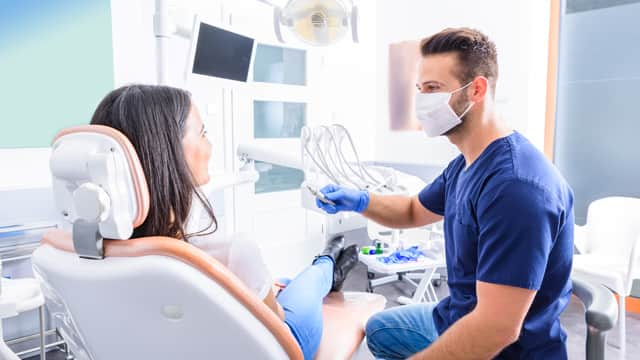-
-

FLUORIDE
What Is Stannous Fluoride Toothpaste?Discover what is Stannous Fluoride Toothpaste and its importance to prevent cavities and other oral health problems.

TEETH WHITENING
Whitening toothpaste - hydrogen peroxide vs. carbamide peroxideIf you lose one or more of your front teeth due to injury or decay, you may feel ...
-
Science & InnovationOral Health Commitment
- Oral Health Commitment
- Bright Smiles, Bright Futures
- Educational Resources
- Mobile Dental Van
- Volunteer
- ORAL HEALTH CHECK
- PRODUCT MATCH
- Oral Health and Dental Care | Colgate®
- Oral Health
- Why Do I Need A Temporary Crown?


Though technology exists to make a permanent crown within a couple of hours rather than two-three weeks, not all dentists have the expensive equipment to create same-day crowns. So, while a dental lab constructs your permanent, custom-made dental crown, you’ll most likely receive a temporary crown.
So, why would your tooth need a temporary crown? Well, the reasons for a temp crown make sense the more you know about the dental crown procedure. And once you have a temporary crown, you’ll want to know how to best care for it.
What's the Procedure for Temporary and Permanent Dental Crown Placement?
If you need a crown for any reason – perhaps to cap a damaged tooth – expect to pay two dental visits. According to Cleveland Clinic, your dental professional will take the following steps.
First Appointment:
- X-ray the problem area and treat any lingering decay. (FYI: If you need a root canal, expect a third dental visit.)
- File down your natural tooth along the sides and at the top. This leaves you with a tooth in the shape of a mini-mountain, onto which your crown will fit.
- Take an impression of the filed tooth – as well as those above and below it – and send these impressions to a dental lab to design your permanent crown.
- Insert a temporary crown with temporary cement.
Though not custom-made to match the fit or color of your natural tooth, the benefits of a temporary crown include:
- Protecting your filed-down tooth and the surrounding gum tissue while the crown is being made.
- Serving as a placeholder, so your other teeth don’t move from their positions in your mouth. (FYI: That would cause a particular problem when you get your customized permanent crown.)
- Giving you the ability to eat and speak normally.
- If the tooth shows when you smile, giving you a more natural look than the nub of your filed tooth.
Second Appointment: When your permanent crown comes in, your dentist removes the temporary crown and fits the permanent crown in its place.
Caring for a Temporary Crown
Because only temporary crown cement affixes your temp crown, you’ll need to treat the prosthetic with some TLC.
Keep in mind these specific care tips:
- After receiving your temp crown, avoid eating or drinking for 30 minutes while the cement sets.
- Very gently clean your teeth with fluoride toothpaste and a soft-bristled brush twice daily.
- Carefully (and daily) floss with an in-out motion instead of up and down to prevent pulling off your crown.
- Stay away from foods that are sticky, chewy, crunchy, tough, hard, or that easily lodge in your teeth. (I’m looking at you, popcorn kernels.) Also, avoid sugary food and drinks that might find a way into any vulnerable spots around your crown.
- Be careful when eating or drinking something hot or cold. Your crowned tooth can be more sensitive.
- If the crown does come off, buy some denture adhesive to affix the crown temporarily. And then schedule a dental appointment asap for a professional cement job.
Having a temporary crown can benefit you in many ways. And if you treat your temp crown royally, it should be just fine as you await the coronation of your permanent crown.
This article is intended to promote understanding of and knowledge about general oral health topics. It is not intended to be a substitute for professional advice, diagnosis or treatment. Always seek the advice of your dentist or other qualified healthcare provider with any questions you may have regarding a medical condition or treatment.
Related Articles

Bridges and crowns
All About Front Tooth CrownsDon't be afraid that a front tooth crown will ruin your smile. With these facts, you can rest assured that your smile can still look healthy and natural.

Bridges and crowns
Tooth Crown Pain: Causes And TreatmentIf you're experiencing tooth crown pain, whether it's a new crown or an established one, you'll need to get it sorted out before you can have real relief..

Bridges and crowns
Tooth Tattoo: What's That?Want to add flair to your smile? Your dentist can help you prepare for a tooth tattoo, a unique form of body art where a design is drawn on a crown.

Bridges and crowns
Porcelain Crowns and Your Valuable SmileA white smile is a powerful statement. Porcelains crown can spruce up a tooth and restore confidence. Find out more about porcelain crowns and its perks.
Related Products

Esse enxaguante bucal multibenefício Colgate Total 12 Carvão Ativado apoia as defesas naturais da sua boca com o zinco. Ele também ajuda a manter os dentes mais brancos, além de combater germes e bactérias para uma limpeza total por até 12 horas.

Colgate Total Alcohol Free* Gum Health Mouthwash delivers 24-hour protection** against bacteria and also helps prevent gum problems

Colgate Total Fresh Mint Toothpaste fights bacteria, the root cause of many oral health issues such as gingivitis, tartar, sensitivity, weak enamel, bad breath, and cavities.

Formulated with Fluoride and with a great mint taste, Colgate Cavity Protection Toothpaste cleans thoroughly, strengthens teeth, and fights cavities.

Helping dental professionals
More professionals across the world trust Colgate. Find resources, products, and information to give your patients a healthier future




